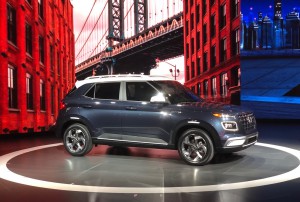
Now that its got its new product line-up right-sized in terms of sport-utility vehicles, Hyundai is expecting big things in the U.S. when it comes to sales and profits.
While reporting its quarterly results, Hyundai officials laid out an aggressive plan to dramatically increase its sales in the U.S. based around its newly expanded portfolio of SUVs. The South Korean automaker for many years offered just two utes: the Tucson and Santa Fe.
However, for much of much of that time, U.S. buyer preferences trended toward SUVs and Hyundai’s offerings were sub-par. The company’s spent much of the last two years adding five new models, most recently the eight-passenger Palisade and its book-end model, the Avenue.
Now it’s counting on this line-up to generate big sales and big profits, as SUVs have for so many of its competitors. Hyundai officials expect the growth to be immediate and impactful
(Hyundai Catering to Low-Price New Car Buyers With Venue)
Officials predicted its market share will rise to 4.2% for 2019 compared with 3.9% last year. The Palisade, which was met with critical praise, is expected to drive much of that. The automake

r is predicting continual growth with its share rising to 5.2% by 2023.
To keep the momentum going in the U.S., which is Hyundai’s largest market outside of South Korea, the company will increase the percentage of SUVs in its U.S. line-up from 51% now to 67% by 2023, matching consumer preferences.
While this move clearly makes sense, there is one potential wrench that could be thrown into the gears. Hyundai is facing a potential labor strike in South Korea. The union walked out of negotiations last week and will vote later this week to approve a strike.
(First Drive: 2020 Hyundai Palisade)
A prolonged strike could halt the momentum the automaker has been building between increased SUV sales as well as the 2020 Sonata, which has also garnered much acclaim. The company saw quarterly profits rise 31.2%.
Hyundai’s net profit for the quarter rose to 919.3 billion won, or $780.44 million, just short of market estimates but still Hyundai’s biggest quarterly percentage gain since the first quarter of 2012, according to Reuters. Operating profit rose 30.2% on a 9.1% increase in revenue, the automaker said in a stock exchange filing.

The company’s strong performance in the U.S. as well as its home market during Q2 help offset slow sales in China. The automotive market in China has been sluggish for some time due to a slow economy and the potential impact of trade talks with the U.S., Reuters reported.
(With Product Blitz Continuing, Hyundai Defies U.S. Market Downturn)
In the April-June period, U.S. sales gained 3% while a weak Korean won against the U.S. dollar raised the value repatriated income. At home, new models such as the Palisade SUV and Sonata sedan helped sales jump 8.1%, Reuters noted.







